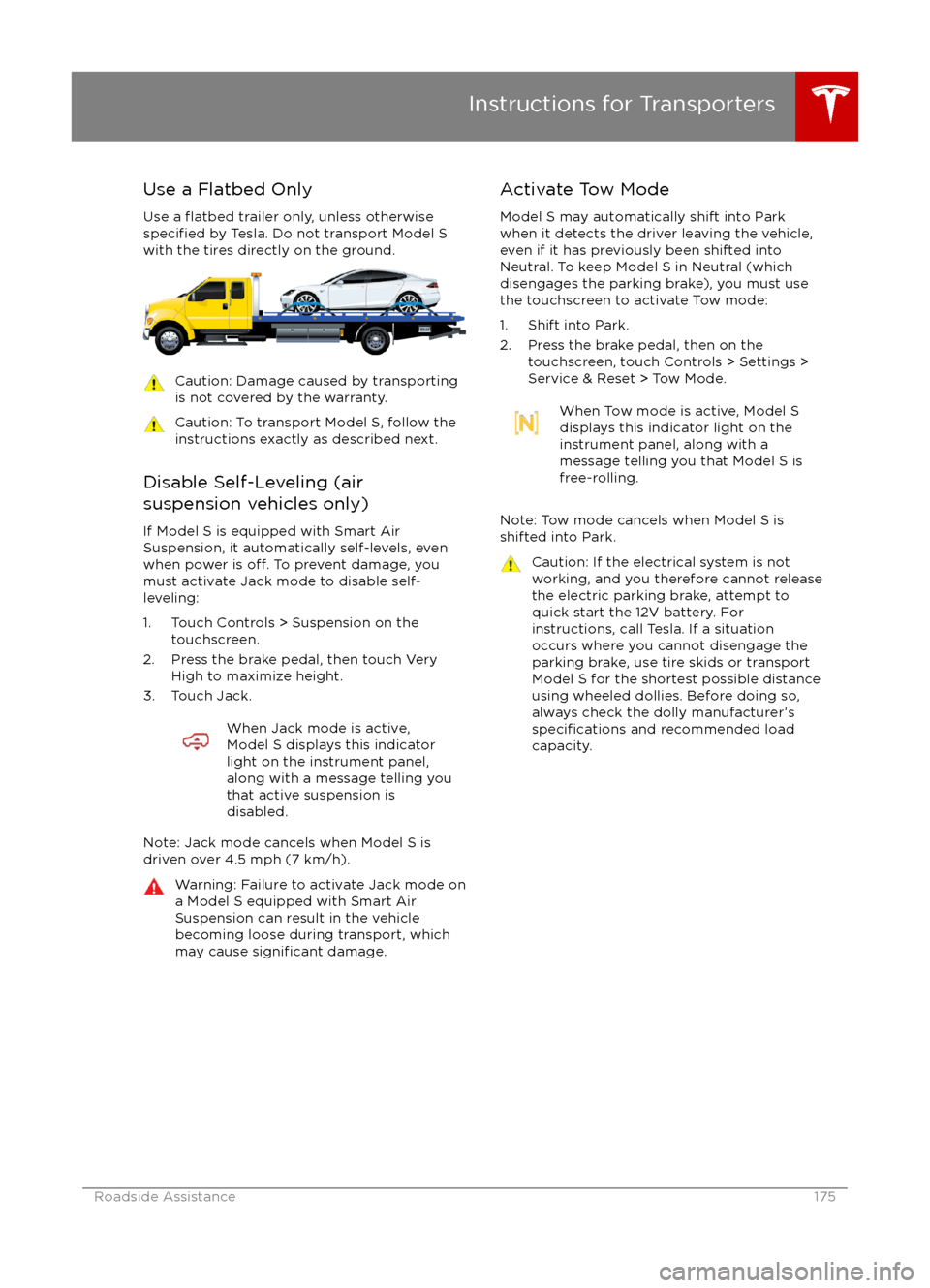Page 175 of 190

Use a Flatbed OnlyUse a
flatbed trailer only, unless otherwisespecified by Tesla. Do not transport Model S
with the tires directly on the ground.
Caution: Damage caused by transporting is not covered by the warranty.Caution: To transport Model S, follow theinstructions exactly as described next.
Disable Self-Leveling (air
suspension vehicles only)
If Model S is equipped with Smart AirSuspension, it automatically self-levels, even
when power is
off. To prevent damage, you
must activate Jack mode to disable self- leveling:
1. Touch Controls > Suspension on the touchscreen.
2. Press the brake pedal, then touch Very High to maximize height.
3. Touch Jack.
When Jack mode is active,
Model S displays this indicator
light on the instrument panel,
along with a message telling you
that active suspension is
disabled.
Note: Jack mode cancels when Model S is
driven over 4.5 mph (7 km/h).
Warning: Failure to activate Jack mode on
a Model S equipped with Smart Air Suspension can result in the vehicle
becoming loose during transport, which
may cause
significant damage.
Activate Tow Mode
Model S may automatically shift into Park
when it detects the driver leaving the vehicle,
even if it has previously been shifted into Neutral. To keep Model S in Neutral (which
disengages the parking brake), you must use
the touchscreen to activate Tow mode:
1. Shift into Park.
2. Press the brake pedal, then on the touchscreen, touch Controls > Settings >
Service & Reset > Tow Mode.When Tow mode is active, Model S
displays this indicator light on the
instrument panel, along with a
message telling you that Model S is
free-rolling.
Note: Tow mode cancels when Model S is
shifted into Park.
Caution: If the electrical system is not
working, and you therefore cannot release
the electric parking brake, attempt to
quick start the 12V battery. For
instructions, call Tesla. If a situation
occurs where you cannot disengage the
parking brake, use tire skids or transport Model S for the shortest possible distance
using wheeled dollies. Before doing so,
always check the dolly manufacturer
Page 176 of 190

Connect the Towing EyeThe method used to connect the winch cabledepends on whether Model S is equipped with
a towing eye (located in the front trunk).
If not equipped with a towing eye:
1. Attach the tow straps to the large hole on each of the rearmost lower suspension
arms underneath the front of the vehicle.
2. To protect the underbody from any damage that could be caused by the tow
straps, place a 2" x 4" piece of wood
between the tow straps and the
underbody.
Caution: Before pulling, position the wood
between the tow strap and the
underbody to ensure the underbody is
protected from any damage that could be caused by the tow strap.If equipped with a towing eye:
1. Locate the towing eye in the front trunk. Pull up the carpet and remove the towing
eye.
2. Remove the nose cone.
Insert a plastic pry tool into the top right
corner, and gently pry the nose cone
toward you. When the clip releases, pull
the nose cone toward you, without
twisting or bending, to release the three
remaining clips.
Note: If the nose cone is equipped with a removable slot, which is distinguished by
the ridge that sits directly below the slot,
remove the slot by prying it from the
bottom and around the edge until the
entire slot is removed.
Instructions for Transporters
176Model S Owner
Page 177 of 190
3. If applicable, disconnect the bumpersensors.
If Model S is equipped with Autopilot
components (see About Driver Assistance
on page 65), you also need to disconnect
the cords for the ultrasonic sensors. To do
so, press down on the tab and pull to release.
4. Insert the towing eye.
Fully insert the towing eye into the
opening on the right side, then turn it
counter-clockwise until securely fastened.
5. Attach the winch cable to the towing eye.
Caution: Before pulling, make sure the
towing eye is securely tightened.Pull Onto the Trailer and Secure the
Wheels
Secure wheels using the eight-point tie-downmethod with basket straps or tie-down straps:
Page 189 of 190

T
telematics 180telephonesteering wheel controls for 38
using 114temperatureBattery (high voltage), limits 129
cabin, controls for 104
outside 37, 43
tires 172
tie-down straps 177
tilt detection 121
Tire and Loading Information label 161
tire noise 138
Tire Pressure Monitoring SystemFCC certification 183
overview of 138
tire pressures, checking 135
tire repair kitinflating with air only 142inflating with sealant 141
replacing the sealant canister 143tiresall-season 137
balancing 136
chains 138
industry glossary of terms 173
inspecting and maintaining 136
pressures, how to check 135
quality grading 172
replacing 137
replacing a tire sensor 139
rotation 136
specification 169
summer 137
temperature grades 172
tire markings 170
tire sealant 140
traction grade 172
treadwear grade 172
winter 138
torque specifications 166
touch up body 146
touchscreenclean mode 145
cleaning 145
Controls 94
overview 90
Settings 99
software updates 125
Tow mode 175
towing 175
towing a trailer 162
towing eye, locating 176
towing instructions 175
TPMSFCC certification 183
overview of 138traction control 56
trademarks 178, 179
traffic alerts 112Traffic-Aware Cruise Control 68
trailer hitches 162
transmission
specifications 166
Transport Canada, contacting 181
transporting 175
trip chart 62
trip information 61
trip overview 116
trip planner 116
trunk, front 12
trunk, rearchild protection lock 7
disabling interior handle 7
TuneIn 111
turn signals 51
U ultrasonic sensors 65
uniform tire quality grading 172
Units & Format 99
Unlock on Park 4
unlockingtrunk, front 12
trunk, rear 10
unlocking and locking doors 4
unlocking when key doesn
Page:
< prev 1-8 9-16 17-24